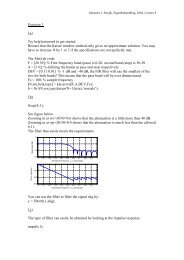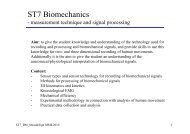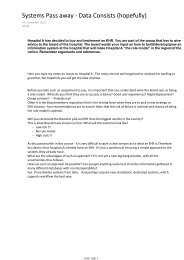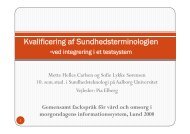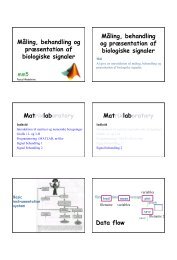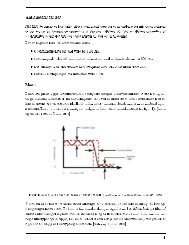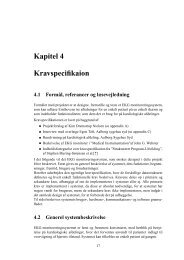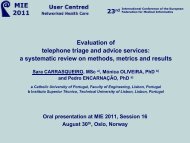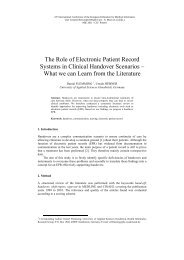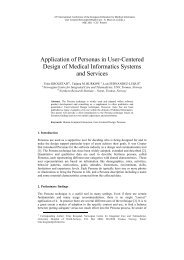Electrical Stimulation
Electrical Stimulation
Electrical Stimulation
You also want an ePaper? Increase the reach of your titles
YUMPU automatically turns print PDFs into web optimized ePapers that Google loves.
Teknologier til behandling: Elektriske stimulationer<br />
Teknologi i sundhedssektoren<br />
KVT, 1. sem., AAU<br />
1
Contents<br />
What can we use electrical stimulations for?<br />
Basic principles<br />
Recovery of movements<br />
TENS<br />
Upper limb<br />
Lower limb<br />
Muscle stimulation<br />
Reflex stimulation
<strong>Electrical</strong> <strong>Stimulation</strong>: Neural Prostheses<br />
CONTROL OF TREMOR<br />
ACTIVATION OF MUSCLES AFTER<br />
RECONSTRUCTIVE TONGUE SURGERY<br />
PHRENIC PACING<br />
CONTROL OF ARM/HAND:<br />
REACHING AND GRASPING<br />
CORRECTION OF SCOLIOSIS<br />
PRESSURE SORE RELIEF<br />
MUSCLE EXERCISING<br />
CONTROL OF LEGS: STANDING<br />
AND WALKING<br />
CONTROL OF EPILEPSY<br />
REDUCTION OF SPASTICITY<br />
RESTORATION OF VISION<br />
RESTORATION OF HEARING (COCHLEAR IMPLANT)<br />
REDUCTION OF SNORING AND SLEEP APNEA<br />
CARDIAC PACING<br />
NERVE REGENERATION<br />
BOWEL EMPTYING<br />
BLADDER EMPTYING AND CONTROL<br />
OF INCONTINENCE<br />
ELECTROEJACULATION<br />
WOUND HEALING<br />
PAIN SUPRESSION<br />
RESTORATION OF SENSORY<br />
FUNCTION
<strong>Electrical</strong> <strong>Stimulation</strong>: Neural Prostheses<br />
A neural prostheses is a system for replacing or augmenting a function that<br />
is lost or diminished because of the injury or disease of the nervous system.<br />
The basic principle for operation of a neural prosthesis is the<br />
activation/stimulation of sensory-motor mechanisms.<br />
Functional <strong>Electrical</strong> <strong>Stimulation</strong> (FES) elicits controlled neural activation by<br />
delivering low level electrical currents.<br />
4
<strong>Electrical</strong> <strong>Stimulation</strong><br />
Neural Prosthesis<br />
Principle of functioning<br />
5
<strong>Electrical</strong> <strong>Stimulation</strong>- Basic principles<br />
Excitation of neuromuscular tissue<br />
<strong>Stimulation</strong> parameters<br />
Modalities of stimulation<br />
nerve-muscle stimulation<br />
reflex stimulation<br />
6
Excitation of neuromuscular tissue<br />
Stimulating current Neural excitation Action potential Impulses<br />
propagate from stimulation site<br />
7
<strong>Electrical</strong> <strong>Stimulation</strong><br />
Factors determining neural excitation<br />
Parameters of the stimulus<br />
Electrode/tissue impedance<br />
Size and location of the electrodes<br />
8
<strong>Electrical</strong> <strong>Stimulation</strong><br />
Factors determining neural excitation<br />
Parameters of the stimulus<br />
Electrode/tissue impedance<br />
Size and location of the electrodes<br />
9
<strong>Electrical</strong> <strong>Stimulation</strong><br />
Recruitment of nerve fibers by changing the stimulation amplitude<br />
Closest and largest fibers are<br />
activated<br />
Also smaller close fibers and<br />
larger distant fibers are activated<br />
10
<strong>Electrical</strong> <strong>Stimulation</strong><br />
Variation of amplitude and pulse duration required for excitation<br />
Current intensity (mA)<br />
Near maximal<br />
Threshold<br />
Pulse duration (µs)<br />
The motor response can be controlled by changing the pulse<br />
intensity and/or duration<br />
11
<strong>Electrical</strong> <strong>Stimulation</strong><br />
Variation of frequency (pulse repetition rate)<br />
The frequency of the stimulus influences the strength and quality<br />
of the evoked motor response<br />
12
<strong>Electrical</strong> <strong>Stimulation</strong><br />
<strong>Stimulation</strong> frequency & Fatigue<br />
The rate at which muscle fatigues during sustained contraction is affected by the<br />
stimulation frequency<br />
Frequency Fatigue<br />
13
<strong>Electrical</strong> <strong>Stimulation</strong><br />
<strong>Stimulation</strong> waveforms<br />
Monophasic (unidirectional) ion flow in one direction<br />
Asymmetric biphasic (bidirectional) ion flow in both directions<br />
Symmetric biphasic (bidirectional) allows both electrodes to depolarize the<br />
neural membrane<br />
14
<strong>Electrical</strong> <strong>Stimulation</strong><br />
Factors determining neural excitation<br />
Parameters of the stimulus<br />
Electrode/tissue impedance<br />
Size and location of the electrodes<br />
Current takes the pathway of least resistance<br />
15
<strong>Electrical</strong> <strong>Stimulation</strong><br />
Factors determining neural excitation<br />
Parameters of the stimulus<br />
Electrode/tissue impedance<br />
Size and location of the electrodes<br />
1) The skin is a good insulator<br />
Current takes the pathway of least resistance<br />
2) Tissue impedance is related to water content<br />
3) Adipose tissue acts as an insulator<br />
4) Muscle tissue conducts current better in the<br />
longitudinal direction<br />
16
<strong>Electrical</strong> <strong>Stimulation</strong><br />
Factors determining neural excitation<br />
Parameters of the stimulus<br />
Electrode/tissue impedance<br />
Size and location of the electrodes<br />
Electrode size determines current density<br />
+ -<br />
Nerve<br />
17
<strong>Electrical</strong> <strong>Stimulation</strong> for Recovery of Movement<br />
Electrode location Motor points<br />
Motor point: the point on a muscle that provides the greatest motor<br />
response with the minimal stimulating current<br />
<br />
Corresponds anatomically with the motor end plate<br />
18
<strong>Electrical</strong> <strong>Stimulation</strong><br />
Modalities of stimulation<br />
Nerve-Muscle stimulation<br />
Primary target: motor nerves<br />
Result: excitation of efferent nerve fibers<br />
(also afferent fibers)<br />
<br />
Muscle contraction<br />
19
<strong>Electrical</strong> <strong>Stimulation</strong><br />
Modalities of stimulation<br />
Reflex stimulation<br />
Primary target: cutaneous sensory nerves<br />
Result: excitation of afferent nerve fibers<br />
eliciting the withdrawal reflex<br />
<br />
Muscle contraction<br />
20
<strong>Electrical</strong> <strong>Stimulation</strong><br />
Production of movements - Summary<br />
Different movements Voluntary production<br />
Contraction strength<br />
Healthy people People with paresis / paralysis<br />
Placement of stimulation<br />
electrodes<br />
Summation Stimulus frequency<br />
Recruitment Stimulus intensity / duration<br />
21
<strong>Electrical</strong> <strong>Stimulation</strong><br />
Upper limb – Surface electrodes<br />
It is impossible to generate a replica of able-bodied movements with surface electrodes,<br />
especially after CNS injury or disease. It is only important to generate movements that<br />
are appropriate for regaining the lost function.<br />
22
<strong>Electrical</strong> <strong>Stimulation</strong> of Muscles<br />
Upper limb – Permanent use<br />
23
<strong>Electrical</strong> <strong>Stimulation</strong> of Muscles<br />
Upper limb – Therapeutic use (FET)<br />
FET: Paretic subjects are required to exercise functional tasks. This exercising<br />
is assisted with a neural prosthesis that controls the opening, grasping,<br />
holding, and releasing functions of selected objects typical for normal daily<br />
activities.<br />
The patterned electrical stimulation is programmed to control flexor and<br />
extensor muscles in a manner that mimics able-bodied opening/closing, and<br />
opening/releasing synergies.<br />
24
<strong>Electrical</strong> <strong>Stimulation</strong> of Muscles<br />
Upper limb – Therapeutic use (FET)<br />
The FET tasks are to actively reach and grasp/release different objects (e.g., can,<br />
telephone receiver, pen, comb, toothbrush). The treatment consists of daily, 30-minute<br />
long sessions, during three consecutive weeks.<br />
25
<strong>Electrical</strong> <strong>Stimulation</strong> of Muscles<br />
Upper limb – Therapeutic use (FET)<br />
0 weeks after 3 weeks<br />
26
<strong>Electrical</strong> <strong>Stimulation</strong> of Muscles<br />
Upper limb – Therapeutic use (FET)<br />
0 weeks after 3 weeks<br />
27
<strong>Electrical</strong> <strong>Stimulation</strong> of Muscles<br />
Lower limb – Permanent use<br />
Single channel stimulation for correcting drop foot<br />
Walk-Aid (left), a single-channel, self-contained stimulator to correct foot-drop problem<br />
(Adapted from Da Silva et al.,1997). The mounting shell is easy to model to the leg<br />
shape and it comprises sensors, electrodes, stimulator and the battery. The KDC 2000A,<br />
Cotas, DK (right) peroneal stimulator to correct foot-drop problems.<br />
28
<strong>Electrical</strong> <strong>Stimulation</strong> of Muscles<br />
Lower limb – Permanent use – Surface stimulation<br />
Walking with single-channel FES system for correction of drop foot.<br />
Popovic et al., Zurich, 2001<br />
29
<strong>Electrical</strong> <strong>Stimulation</strong> of Muscles<br />
Lower limb – Permanent use – Implantable electrodes<br />
1 . T h e i m p l a n t<br />
a . D i g i t a l 4 - c h a n n e l n e r v e s t i m u l a t o r<br />
I m p l a n t e d u n d e r t h e s k i n a n d c o n t a i n s t h e<br />
e l e c t r o n i c c i r c u i t r y a n d t h e r e c e i v i n g a n t e n n a<br />
f o r p o w e r a n d c o n t r o l .<br />
b . M u l t i - l e a d c a b l e s w i t h i n - l i n e c o n n e c t o r<br />
c . T h e 1 2 c o n t a c t e l e c t r o d e c u f f<br />
P l a c e d a r o u n d t h e p e r o n e a l n e r v e a t a p l a c e<br />
w h e r e t h e n e r v e c o n t a i n s a l m o s t a l l n e r v e<br />
f i b e r s g o i n g t o t h e m u s c l e s t h a t l i f t t h e f o o t .<br />
P e r o n e a l<br />
n e r v e<br />
A n k l e<br />
d o r s i f l e x o r<br />
m u s c l e ( s )<br />
2 . P r o g r a m m a b l e s t i m u l u s c o n t r o l a n d p o w e r u n i t<br />
C o n t a i n s m i c r o c o n t r o l l e r a n d i n d u c t i v e t r a n s m i t t e r f o r p o w e r i n g<br />
a n d c o n t r o l l i n g t h e i m p l a n t ( 1 ) .<br />
P r o g r a m m a b l e v i a a P C f o r o p t i m a l f u n c t i o n a l i t y .<br />
T h e u n i t i s s m a l l e n o u g h t o f i t i n t o a p o c k e t a n d i s p o w e r e d b y a<br />
r e c h a r g a b l e b a t t e r y .<br />
3 . H e e l s w i t c h<br />
W h e n t h e f o o t i s l i f t e d f r o m t h e g r o u n d t h e<br />
h e e l s w i t c h s i g n a l s t h i s ( b y w i r e o r w i r e l e s s )<br />
t o t h e e x t e r n a l c o n t r o l u n i t ( 2 ) .<br />
30
<strong>Electrical</strong> <strong>Stimulation</strong> of Muscles<br />
Lower limb – Permanent use – Implantable electrodes<br />
B<br />
D<br />
A<br />
An implantable stimulator (D) (Ljubljana, Slovenia) comprising: a heel switch (A),<br />
an external stimulator with a single AA battery, an emitting RF-antenna (B); and<br />
the implant receiver-electrodes (C) that is attached to the common peroneal<br />
nerve.<br />
C<br />
31
<strong>Electrical</strong> <strong>Stimulation</strong> of Muscles<br />
Lower limb – Permanent use – Implantable electrodes<br />
Actigait®, Neurodan, DK – implantable multichannel drop foot system using a<br />
multi-contact cuff interface<br />
32
<strong>Electrical</strong> <strong>Stimulation</strong> – Reflex activation<br />
Lower limb – Surface stimulation<br />
Reflex stimulation during the swing phase of the gait cycle<br />
33
<strong>Electrical</strong> <strong>Stimulation</strong> – Reflex activation<br />
Lower limb – Surface stimulation<br />
The nociceptive withdrawal reflex (NWR)<br />
The NWR is a polysynaptic spinal<br />
reflex intended to protect the body<br />
from damaging stimuli.<br />
34
<strong>Electrical</strong> <strong>Stimulation</strong> – Reflex activation<br />
Lower limb – Surface stimulation<br />
The nociceptive withdrawal reflex (NWR)<br />
Painful electrical stimulation<br />
1 ms<br />
200 Hz<br />
It evokes a short lasting, sharp,<br />
pinpricking sensation at the stimulation site<br />
35
<strong>Electrical</strong> <strong>Stimulation</strong> – Reflex activation<br />
Lower limb – Surface stimulation<br />
Single stimulus vs. repetitive stimulation<br />
Ankle joint kinematics – healthy subjects – sitting position<br />
20 degrees<br />
-10<br />
36
<strong>Electrical</strong> <strong>Stimulation</strong> – Reflex activation<br />
Lower limb – Surface stimulation<br />
Effect of stimulating during gait<br />
37
<strong>Electrical</strong> <strong>Stimulation</strong> – Reflex activation<br />
Lower limb – Surface stimulation<br />
Clinical study to test whether FET based on reflex activation, applied in<br />
acute hemiplegic patients during gait training produces greater<br />
improvement in gait function than intensive gait training alone.<br />
38
<strong>Electrical</strong> <strong>Stimulation</strong> – Reflex activation<br />
Lower limb – Surface stimulation<br />
Inclusion test<br />
Stand and walk without therapist’s support
<strong>Electrical</strong> <strong>Stimulation</strong> – Reflex activation<br />
Lower limb – Surface stimulation<br />
Training session<br />
Without stimulation With stimulation<br />
40
<strong>Electrical</strong> <strong>Stimulation</strong> – Reflex activation<br />
Lower limb – Surface stimulation<br />
Before<br />
After<br />
Evaluation sessions<br />
Control Treatment<br />
41
<strong>Electrical</strong> <strong>Stimulation</strong> – Reflex activation<br />
Lower limb – Surface stimulation<br />
Increment in FAC test's level<br />
4<br />
3<br />
2<br />
1<br />
0<br />
General walking condition: Functional Ambulation Category Test<br />
Control<br />
Treatment<br />
FAC test<br />
Before After 1 m. after 6 m. after<br />
*<br />
Evaluation session<br />
FAC Test<br />
0: Patient can not walk or needs<br />
help from 2 or more therapists<br />
1: Patient needs constant help from<br />
one therapist for weight support and<br />
balance<br />
2: Patient needs constant or<br />
intermittent help from a therapist to<br />
keep balance and coordination<br />
3: Patient needs verbal guidance<br />
4: Patient needs help for stairs or<br />
uneven ground<br />
5: Patient walks alone<br />
42
TENS: Transcutaneous <strong>Electrical</strong> Nerve <strong>Stimulation</strong><br />
Transcutaneous electrical nerve stimulation (TENS) is a simple, noninvasive<br />
analgesic technique that is used extensively in health-care settings.<br />
It can be administered in the clinic by healthcare professionals or at home<br />
by patients who have a TENS device.<br />
TENS is mainly used for the symptomatic management of acute and<br />
nonmalignant chronic pain. It is also claimed that TENS has tissue-healing<br />
effects although it is used less often for these actions.<br />
43
Analgesic effects of TENS (Claims!)<br />
Relief of acute pain<br />
Postoperative pain<br />
Labor pain<br />
Dysmenorrhoea<br />
Musculoskeletal pain<br />
Bone fractures<br />
Dental procedures<br />
Relief of chronic pain<br />
Low back pain<br />
Arthritis<br />
Stump and phantom pain<br />
Postherapeutic neuralgia<br />
Trigeminal neuralgia<br />
Peripheral nerve injuries<br />
Angina pectoris<br />
Facial pain<br />
Metastatic bone pain<br />
44
Non-Analgesic effects of TENS (Claims!)<br />
Postoperative nausea associated with opioid medication<br />
Nausea associated with chemotherapy<br />
Morning sickness<br />
Motion/travel sickness<br />
Improving blood flow<br />
Reduction in ischemia after reconstructive surgery<br />
Reduction of symptoms associated with diabetic neuropathy<br />
Improved healing of wounds and ulcers<br />
45
TENS: The Pain Gate<br />
Under normal physiological circumstances, the brain generates pain<br />
sensations by processing incoming noxious information arising from stimuli<br />
such as tissue damage.<br />
In order for noxious information to reach the brain it must pass through a<br />
metaphorical ―pain gate‖ located in lower levels of the central nervous<br />
system. The hypothesis is that TENS ―closes‖ the Pain Gait.<br />
46
TENS: dosage<br />
Clinical trials report that maximum pain relief occurs when the TENS device is<br />
switched on and that the analgesic effect usually disappears quickly once the device<br />
is switched off.<br />
Long-term users of TENS: 75% used TENS on a daily basis and 30% reported using<br />
TENS for more than 49 hours a week.<br />
Monitor skin condition under the electrodes on a regular basis and take regular<br />
(although short) breaks from stimulation!<br />
Some patients report post stimulation analgesia lasting between 18 and 2 hours<br />
47
TENS: Electrode positions for common pain conditions—anterior view.<br />
48
TENS: Electrode positions for common pain conditions—posterior view.<br />
49
TENS: Contraindications<br />
People suffering from epilepsy<br />
Women in the first trimester of pregnancy. However, TENS is routinely<br />
administered on the back to relieve pain during labor<br />
Patients with cardiac pacemakers: this is because the electrical field generated by<br />
TENS could interfere with implanted electrical devices.<br />
Undiagnosed pain (unless recommended by a medical practitioner)<br />
People with heart disease (unless recommended by a cardiologist)<br />
Do not apply TENS: over the carotid sinus, on broken skin, and internally<br />
(mouth)<br />
50
<strong>Electrical</strong> <strong>Stimulation</strong>: Neural Prostheses<br />
CONTROL OF TREMOR<br />
ACTIVATION OF MUSCLES AFTER<br />
RECONSTRUCTIVE TONGUE SURGERY<br />
PHRENIC PACING<br />
CONTROL OF ARM/HAND:<br />
REACHING AND GRASPING<br />
CORRECTION OF SCOLIOSIS<br />
PRESSURE SORE RELIEF<br />
MUSCLE EXERCISING<br />
CONTROL OF LEGS: STANDING<br />
AND WALKING<br />
CONTROL OF EPILEPSY<br />
REDUCTION OF SPASTICITY<br />
RESTORATION OF VISION<br />
RESTORATION OF HEARING (COCHLEAR IMPLANT)<br />
REDUCTION OF SNORING AND SLEEP APNEA<br />
CARDIAC PACING<br />
NERVE REGENERATION<br />
BOWEL EMPTYING<br />
BLADDER EMPTYING AND CONTROL<br />
OF INCONTINENCE<br />
ELECTROEJACULATION<br />
WOUND HEALING<br />
PAIN SUPRESSION<br />
RESTORATION OF SENSORY<br />
FUNCTION<br />
51



